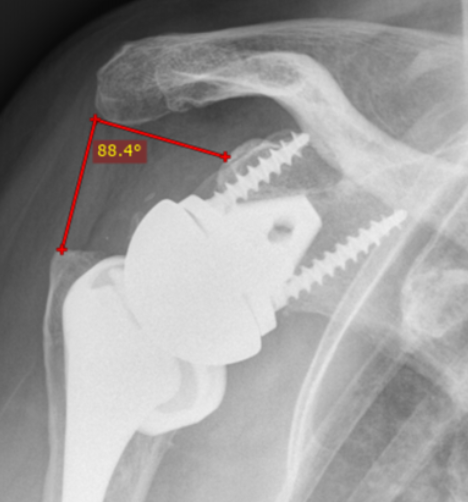
It seems curious that distalization (a linear dimension) is being measured as an angle, rather than as a linear dimension (see yellow line) and

that laterialization (a linear dimension) is being measured as an angle, rather than as a linear dimension (see yellow line).

A recent article Reverse shoulder arthroplasty design inlay vs. onlay: does it really make a difference? emphasized the importance of distalization and lateralization to the outcome of reverse total shoulder and showed a similar method for the linear measurement of each of these linear dimensions.

The authors point out that humeral distalization and lateralization depend on (a) whether the implant is “inlay” or “onlay” in design,

(b) the placement of the humeral implant in the bone,

and (c) the position and geometry of the glenosphere.

Fortunately, the readily available PACS (Picture Archiving and Communication System) makes measurement of distalization (white) and lateralization (yellow) on plan films quite straightforward.

These tools can make the same measurements on the preoperative film, so that the change in distalization and lateralization can be quantified. In this example, the reverse total shoulder medicalized the humerus by 1.9 mm and distalized in by 24 mm.

Making these linear measurements in a standard way sets the stage for assessing the effect of humeral lateralization and distalization on patient outcomes.
Position is everything

Anna’s Hummingbird
Anne’s garden, Seattle
Spring 2021
Follow on twitter/X: https://x.com/RickMatsen
Follow on facebook: https://www.facebook.com/shoulder.arthritis
Follow on LinkedIn: https://www.linkedin.com/in/rick-matsen-88b1a8133/
Here are some videos that are of shoulder interest
Shoulder arthritis – what you need to know (see this link).
How to x-ray the shoulder (see this link).
The ream and run procedure (see this link).
The total shoulder arthroplasty (see this link).
The cuff tear arthropathy arthroplasty (see this link).
The reverse total shoulder arthroplasty (see this link).
The smooth and move procedure for irreparable rotator cuff tears (see this link)
Shoulder rehabilitation exercises (see this link).

